I won’t be the first to admit I spend over an hour a day scrolling through social media. I see what my friends and family are up to, check out the news, and occasionally Facebook stalk the cousin of that distant acquaintance from high school.
I’d hardly say I go on social media to read about my favorite companies and brands. And yet, when I think about it, most of us—myself included—actually do.
That tempting Facebook video about the 5 best cookie recipes with Hershey’s Chocolate Kisses? Branded content. Those stunning Instagram photos of Airbnbs? Branded content. That ad my friend shared that made all of us cry? Also branded content.
Branded social media posts, at their best, make us forget we’re the target audience of an elaborate marketing strategy. We find we actually enjoy the witty Tweets, the inspirational videos, and the beautiful photographs—and that we’re eager to come back for more.
Why Does Your Brand Need a Social Media Presence?

Social media is a fundamental tool for organic marketing.
Organic marketing—a critical part of any business’s marketing strategy—is the act of drawing customers to your brand using unpaid strategies like content creation, search engine optimization (SEO), and social media pages.
The idea is that the more value you offer prospective customers, the more they’ll be drawn to you “naturally,” irrespective of paid or boosted posts.
A branded social media presence on channels like Facebook, Instagram, Pinterest, YouTube, Twitter, and more helps you reach new prospective customers and build emotional connections with your audience. These emotional connections humanize your brand, making your brand appear authentic and relatable.
A social media presence also helps you strengthen your brand’s identity and messaging, building brand recognition among your target audience.
What to Focus on When Building Your Brand on Social Media

Despite what you might think, the goal of social media branding is not to make your brand go viral overnight.
While instant fame and attention would be nice in theory, the quality of a “viral” audience will be much lower than one that you build over time with continuous communication.
Also—it’s not realistic. Good branding on social media is an ongoing process, one in which you’re continuously communicating with your audience—responding to their comments on your images, finding new ways to engage with them, etc.
Additionally, it’s important to find the right networks for your brand. You may not have time to establish a brand presence on multiple social media platforms, and not every social media page will have the right audience for your brand anyway. Instead, you’ll want to find where your audience hangs out and focus your efforts on those channels.
With this in mind, there are a few things you want to pin down before creating a social media branding strategy:
Your audience
Like with any type of branding, your audience should be at the center of everything you do. You’re branding to them, which means that you have to understand who they are, what they like and dislike, and how they like to be spoken to.
Try to pin down your audience’s average age, their demographic backgrounds, and even their interests and hobbies. This will help you decide how best to communicate with them and figure out which social media platforms they’re most likely to hang out on.
Your brand identity
Besides for knowing your audience, you also need to know your business. Ideally, you’ll have created a brand identity, one that is centered around your brand’s main values and message.
How do you differentiate your brand from competitors? Who do you help and how? How do you visually express these values? With your brand identity at the forefront of your mind, it will be easier to come up with the right messaging.
Your imagery and designs
Your brand imagery is crucial for social media, as images instantly catch the eye and increase the chances of your audience engaging with your content (especially on platforms like Instagram and Pinterest).
However, to effectively build your brand on social media, you’ll need to have a clear idea of what kinds of images align with your brand identity—including themes, colors, and fonts—before you start posting content. (We’ll discuss this more in detail below.)
Your content
The way to your audience’s heart is ultimately through the content you share, be it funny, sweet, sentimental or professional. There are so many types of content you can share on your feed; the trick is finding what resonates, and then stick to it. Familiarize yourself with various content types—from infographic to long-form blog post—and try to understand which types your audience will most connect with.
To test different types of content and organize your social media content strategy, you’ll want to create a content calendar with posts planned for the next 3 months. Include fun social media holidays as well as weeks in which nothing special is going on. Plan to post at different times of the day and on varying days of the week, so you can analyze when your audience is most active and refine your strategy accordingly.
7 Strategies for Nailing Your Social Media Branding

1. Achieve consistency across channels
Consistency is the foundation of strong branding.
By consistent branding, we mean that every element of your branding strategy needs to be the same across all channels—your website, social media pages, emails, and more—so that your brand’s personality is powerful and believable. These branding elements include:
– Your brand story
– Your brand voice
– Your logo
– Your style of imagery
– Your color palette
– Your typography
Make these 6 elements the same across all channels, and you’ll cultivate a personality your brand can claim as its own.
Take a look at beauty brand Sephora’s Facebook page below.
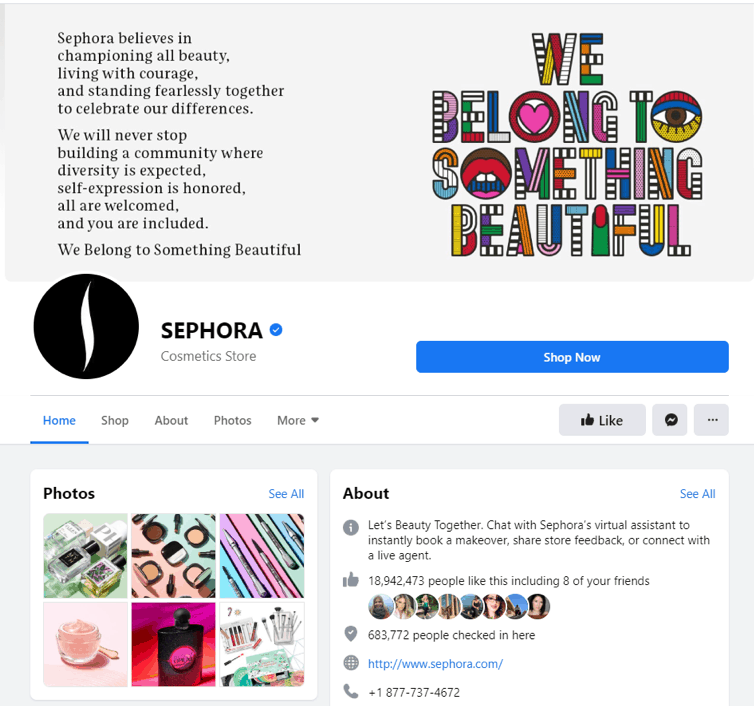
Now, take a look at Sephora’s YouTube channel. What do you notice?
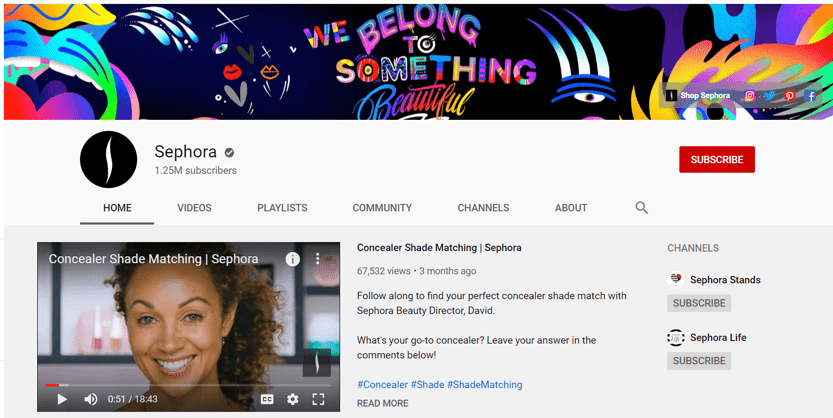
Understandably, the 2 pages have differences, since they’re built for different audiences with different desires and needs. The YouTube page focuses on video tutorials, while the Facebook page primarily shows images of products.
But despite these differences, the branding on both pages remains consistent. We can navigate to each page and, even without reading Sephora’s name, understand that they belong to the same company thanks to the same logo, a similar visual style and color palette, and the same tagline.
By branding yourself consistently across social media channels, you give your company a single personality that users can identify as uniquely your own. In doing so, you make your brand memorable and build brand recognition among your audience.
2. Make your visuals distinct
You can further build brand recognition with a distinct logo, color palette, and visual style that makes you stand out from your competitors.
Ideally, you’ll be able to create a brand image that your audience recognizes instantly. Think of Starbucks’s green mermaid or Sephora’s sleek black and white aesthetic. These brands have cultivated an immediate visual association with their brand—one so powerful that we can recognize the brands even without the company names.
McDonalds’ Instagram page depicts vibrant images of food and happy customers, but where it really shines is in the consistency of its color palette. The company finds creative ways to use its classic red and yellow color.
We love the red and yellow flip-flops that subtly form the shape of McDonald’s golden arches in the screenshot below. The person holding the flip-flops is wearing red nail polish, just as the young girl in the image on the bottom right is wearing a red and yellow outfit.
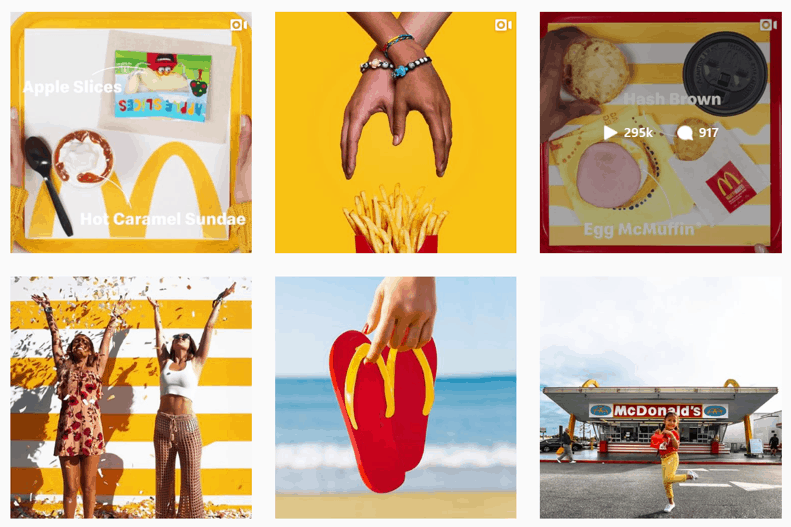
McDonald’s thinks of creative ways to consistently apply its logo and color palette across its Instagram page, down to the tiniest details. The result is a social media page that provides meaningful content while conveying the essence of the brand.
3. Always stick to your brand voice
Your brand voice is the way your company speaks. This includes your tone, choice of language, and the personality your brand evokes as a result.
You should stick to a consistent brand voice across all customer touch points, from your website copy and landing pages to your marketing emails, ads, and social media strategy. The more consistent your brand voice, the stronger and more recognizable your brand’s distinct personality.
On its Facebook page, outdoor clothing company The North Face uses a combination of brand language and tone to sound rugged, adventurous, and inspirational.
The company could just write, “We have a stylish new outdoor collection,” but they don’t. Instead, they inspire us with a #neverstopexploring hashtag, coupled with a command— “Put exploration on your wish list”—that is bold and suggestive of adventure.

The power of brand voice lies in its ability to evoke emotion in your audience, rather than simply describe or promote. Appeal to the emotions of your target audience and spread a consistent message about your brand by using the same brand voice across all your social media channels.
4. Engage with your audience
A basic fundamental of any social media strategy is to engage, engage, engage.
Respond to private messages from customers as quickly as possible, and answer customer comments. Even once you have beautiful, thoughtfully crafted, perfectly branded social media pages, failure to engage with your followers will make them feel disinterested and detached from your brand.
It’s impossible to please everyone, and there will inevitably be times when a customer expresses dissatisfaction or disappointment in their comment. Rather than feel discouraged, use these comments as an opportunity to show off your great customer service to the rest of your followers.
Remember to be pleasant and polite, like Lyft in the Facebook comment below, to show your customers that you have their best interests at heart.
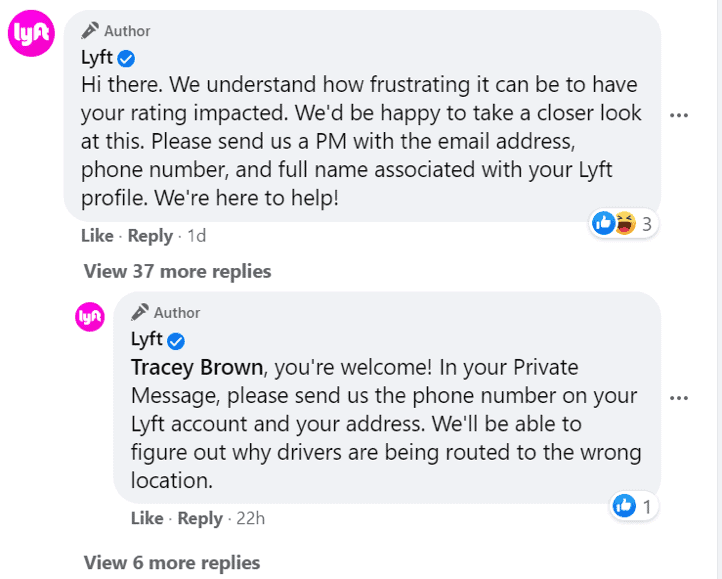
By engaging with followers on social media, you can strengthen your relationship with both existing and prospective customers. Your goal is for high engagement that not only generates new leads but also improves customer retention.
5. Showcase your brand story
By now, you probably have a brand story that explains the mission and values of your brand. To truly leverage this story, you’ll need to take it beyond your website’s About section. On your social media pages, you can prove to the world that you’re living by your brand story—that you’re not just talking the talk, but actually walking the walk.
Videos and photographs touching back to your brand story are great ways to carry out your brand promise.
GoPro’s brand story centers on the principle that “Sharing our experiences make them more meaningful and way more fun.” By sharing the experiences of its customers on social media, the brand stays true to this principle and proves to its followers that shared experiences have meaning and value.
The GoPro Instagram page takes us on a journey through its users’ lives, letting us see through other people’s eyes as they dance the streets of Seoul, skydive in Mexico, and more.

Use social media to draw people into your brand story. Posting user-generated content is a particularly effective way to show the world that you’re true to your values and are successfully carrying out your brand’s mission and purpose.
6. Embrace honesty and transparency
Honesty and transparency make your brand more likeable. Humanize your company and your product by explaining the mechanics of your brand—like how ideas are created, how products are built, or what employees do in their free time.
Just as you get to know a person better when your conversations go below the surface, get your customers to know the real “you” by taking them on a deep dive into your brand.
Videos and images are effective tools for building transparency, because they let customers see the brand through the eyes of its employees and creators. Post behind-the-scenes content that doesn’t feel too polished and that lets viewers have an authentic interaction with your brand.
General Electric, a multinational conglomerate that produces electrical products and materials, is a brand difficult for many customers to connect with. I mean, do any of us feel personally connected to the brand that manufactures our light bulbs?
But a look at the General Electric’s Tumblr changes our minds. The company posts photos from the factory floor, giving us a glimpse into the process of product creation and a day in the life of its employees

In the photo above, GE gives us the employee’s name—Emily. Emily is a process engineer in Alabama, and she’s super talented at building complex components.
Now that we think about it, this LEAP jet engine—which we knew nothing about before—actually sounds pretty cool. General Electric seems to be doing some cutting-edge work, and we like the way they recognize and appreciate its employees’ talent.
That’s the power of transparency. When a brand shows a glimpse of who they actually are, they go from feeling cold and detached to warm and human, and we like them all the better for it. Your social media pages are the best place to post images and video that provide a transparent window into your brand.
7. Find opportunities for humor
If you’ve ever traveled to a different country, you know that a good laugh transcends barriers in language, culture, and identity. Just as humor is one of the best ways for people to connect with one another, it’s also one of the most effective ways for companies to connect with their target audience.
Humor is also helpful if you have a brand or product that others might mock, like the toilet paper company Charmin. Rather than let others laugh at it, Charmin uses its Twitter account to show the world that it doesn’t take itself too seriously. In doing so, it earns the respect and admiration of its audience and forms a bond with them as a result.
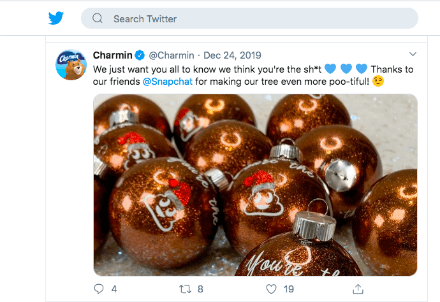
Humor on social media helps you form deep personal connections with your target audience and makes your brand stand out. Social media, especially Facebook, is flooded with advertising, and many users have become immune. Rather than let users scroll past without a second thought, use humor to make your post—and your brand—memorable.
Over to You
By building your brand’s social media presence, you can cultivate your brand’s personality and deepen your relationship with customers.
Strengthen your social media strategy by engaging constantly with your audience, giving followers behind-the-scenes windows into your brand, using consistent visuals and brand voice, and more. The stronger and more effective your company’s social media presence, the more leads you’ll acquire and the more customers you’ll retain.
